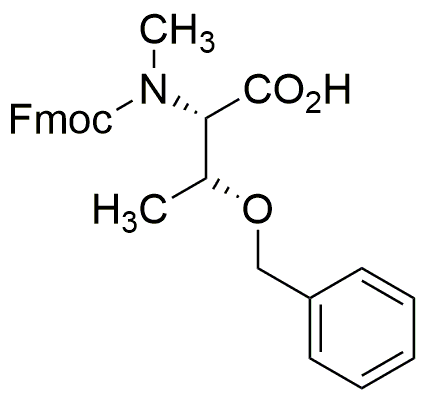Fmoc-N-methyl-O-benzyl-L-threonine is widely utilized in research focused on:
- Peptide Synthesis: This compound serves as a crucial building block in the synthesis of peptides, allowing for the introduction of specific amino acid sequences in drug development.
- Drug Design: Its unique structure enables researchers to create more effective and targeted therapeutic agents, particularly in the field of oncology and neurology.
- Bioconjugation: The chemical is employed in bioconjugation processes, facilitating the attachment of biomolecules to drugs or imaging agents, enhancing their efficacy and specificity.
- Research in Protein Engineering: It aids in the modification of proteins, providing insights into protein structure and function, which is essential for developing novel biopharmaceuticals.
- Analytical Chemistry: The compound is used in various analytical techniques, including chromatography, to separate and identify complex mixtures in biological samples.
General Information
Properties
Safety and Regulations
Applications
Fmoc-N-methyl-O-benzyl-L-threonine is widely utilized in research focused on:
- Peptide Synthesis: This compound serves as a crucial building block in the synthesis of peptides, allowing for the introduction of specific amino acid sequences in drug development.
- Drug Design: Its unique structure enables researchers to create more effective and targeted therapeutic agents, particularly in the field of oncology and neurology.
- Bioconjugation: The chemical is employed in bioconjugation processes, facilitating the attachment of biomolecules to drugs or imaging agents, enhancing their efficacy and specificity.
- Research in Protein Engineering: It aids in the modification of proteins, providing insights into protein structure and function, which is essential for developing novel biopharmaceuticals.
- Analytical Chemistry: The compound is used in various analytical techniques, including chromatography, to separate and identify complex mixtures in biological samples.
Documents
Safety Data Sheets (SDS)
The SDS provides comprehensive safety information on handling, storage, and disposal of the product.
Product Specification (PS)
The PS provides a comprehensive breakdown of the product’s properties, including chemical composition, physical state, purity, and storage requirements. It also details acceptable quality ranges and the product's intended applications.
Certificates of Analysis (COA)
Search for Certificates of Analysis (COA) by entering the products Lot Number. Lot and Batch Numbers can be found on a product’s label following the words ‘Lot’ or ‘Batch’.
*Catalog Number
*Lot Number
Certificates Of Origin (COO)
This COO confirms the country where the product was manufactured, and also details the materials and components used in it and whether it is derived from natural, synthetic, or other specific sources. This certificate may be required for customs, trade, and regulatory compliance.
*Catalog Number
*Lot Number
Safety Data Sheets (SDS)
The SDS provides comprehensive safety information on handling, storage, and disposal of the product.
DownloadProduct Specification (PS)
The PS provides a comprehensive breakdown of the product’s properties, including chemical composition, physical state, purity, and storage requirements. It also details acceptable quality ranges and the product's intended applications.
DownloadCertificates of Analysis (COA)
Search for Certificates of Analysis (COA) by entering the products Lot Number. Lot and Batch Numbers can be found on a product’s label following the words ‘Lot’ or ‘Batch’.
*Catalog Number
*Lot Number
Certificates Of Origin (COO)
This COO confirms the country where the product was manufactured, and also details the materials and components used in it and whether it is derived from natural, synthetic, or other specific sources. This certificate may be required for customs, trade, and regulatory compliance.


